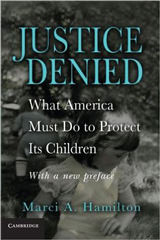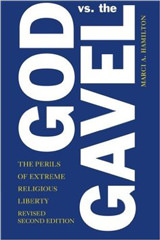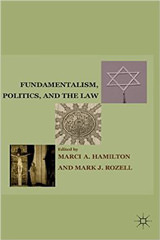Ever since 1997, when the Supreme Court struck down the federal Religious Freedom Restoration Act (RFRA) as unconstitutional in Boerne v. Flores, religious lobbyists have sought to recreate the Act in various forms. For instance, they sought to re-enact the federal RFRA as the Religious Liberty Protection Act. But that move was halted when a variety of organizations counter-lobbied, explaining to Congress that it was giving religious actors more latitude to break most laws. Such laws, moreover, included those that protect children from medical neglect and abuse; ensure community-based land-use planning; and guarantee that housing is nondiscriminatory.
Still, having failed at the federal level, religious actors later sought to enact RFRAs at the state level. The federal RFRA thus established the template for a movement, in the states, of religious lobbyists seeking to enact laws that assist religious actors in avoiding state and local laws.
The RFRA formulation provides statutory rights well beyond what the federal Constitution provides. Thus, we now have a universe in which there are constitutional free exercise rights and statutory free exercise rights. It is a mistake to confuse the two. The former are mandated by the First Amendment (and state constitutional religion clauses); the latter by legislative fiat.
The typical formula these laws set forth goes as follows:
- To obtain the benefits of a RFRA statute, the believer or organization first must carry a burden to prove that the law imposes a “substantial burden” on religious practice;
- Then, if the believer can prove a substantial burden, the burden shifts to the government to prove that the law “serves a compelling interest” and is the “least restrictive means” to accomplish that interest. If the government fails to justify its law under this strictest of standards, the religious actor is not required to abide by the law.
The History of the Federal RFRA and RLUIPA
The federal RFRA was enacted after legal experts and religious entities misled members of Congress into believing that the Supreme Court had applied strict scrutiny—the most demanding form of Court review—across the board in cases involving the free exercise of religion. That was not just an exaggeration; it was a bald misstatement of the existing law.
Moreover, there was no excuse for that misstatement, other than political motivation, for, as the Court itself explained in 1990, in Employment Div. v. Smith, the “vast majority” of its free exercise cases had not employed strict scrutiny. Thus, it was the height of arrogance for law professors like Douglas Laycock to tell Congress that the Court had done the very opposite of what the Court itself said it had. Their misrepresentations prevailed, however, and, in 1993, the federal RFRA was born. Thus was born an era of foolhardy legislation.
The longer the federal RFRA was in place, the clearer it became that while the law was perhaps well-intentioned, it harbored a dark underside, for under the law, children could be abused and medically neglected simply because those who were harming them or putting them at risk were religious. Residential neighborhoods could be subjected to uses never contemplated when the owners purchased their homes; and religious actors could argue that they were not bound by just about any law governing everyone else.
It took the Supreme Court’s decision in Boerne v. Flores, which held RFRA unconstitutional, to slow the movement toward extra-constitutional free exercise rights, but the will of religious actors to exceed constitutional standards did not abate.
When religious entities (or anyone else) have broad power to violate the law, serious public policy consequences can ensue, and that was the case here. Once that truth became known, and members of Congress lost interest in a law with the scope of RFRA, religious activists narrowed the scope of their demands. Rather than continuing to support a full RFRA substitute, which would have applied to every law in the country (and would, predictably, be struck down by the Supreme Court as RFRA had been) they shifted their support to the 2000 Religious Land Use and Institutionalized Persons Act (“RLUIPA”), which only covers land-use law and state-run institutions (primarily including prisons).
The Movement Seeking State RFRAs
Religious activists also fanned out to cover the 50 states, seeking to obtain the passage of individual state RFRAs. The conservative Rutherford Institute led the way.
About a dozen state RFRAs were passed, but with each new bill, those protecting the vulnerable worked to limit the bill’s scope. For example, in Pennsylvania, the RFRA does not cover crimes against children. Eventually, the momentum for the state RFRA movement died, and a number of states rejected (and never subsequently enacted) RFRAs: California, Georgia, Kansas, Maryland, Michigan, New Hampshire, New Jersey, New York, Oregon, Vermont, Hawaii, Indiana, Kansas, Kentucky, Nevada, Oregon, New York, North Carolina, and, most recently, West Virginia.
A new—and troubling—iteration of the legislation has just appeared on the horizon, however. Legislatures had become inhospitable to the blunderbuss approach to religious accommodation posed by a RFRA. It is a dangerous formula that on its surface appears so attractive—religious liberty! But at base, it creates unimagined opportunities for disturbing violations of law. The generic phrase “religious freedom” focuses on the apple pie and motherhood part of the statute, as it distracts us from the dark reality that breaking a law typically means someone gets hurt.
The latest version of a state RFRA abandons the state legislatures—which are, by now, well-educated about the RFRAs’ important downsides—and instead offers RFRAs directly to the people, via state initiative procedures. The first such RFRA will be on the June 12 ballot in North Dakota.
This is an interesting development, because the move to direct democracy is obviously motivated by frustration with the legislatures, but the difference in North Dakota is not just a change in the relevant political process. It is a substantive change in the law, as well, for the North Dakota initiative is even more far-reaching than the original RFRA formulation. It bodes ill for the vulnerable.
The North Dakota proposed RFRA states:
Government may not burden a person’s or religious organization’s religious liberty. The right to act or refuse to act in a manner motivated by a sincerely held religious belief may not be burdened unless the government proves it has a compelling governmental interest in infringing the specific act or refusal to act and has used the least restrictive means to further that interest. A burden includes indirect burdens such as withholding benefits, assessing penalties, or an exclusion from programs or access to facilities.
While this language shares some features with that of the original RFRA, the proposed North Dakota RFRA goes farther for the religious actor, showing that religious lobbyists are becoming more demanding and creative. For example, the North Dakota RFRA is triggered by a mere “burden” on religious liberty, not—as in the original RFRA, and the Constitution’s Free Exercise Clause—only where the religious actor can prove a “substantial burden.” That means a de minimis burden could trigger the initiative’s protection. And that means, in turn, that if the North Dakota initiative becomes law, the door will be wide open for every religious believer who is suffering even the most minimal of inconveniences to simply avoid the law —regardless of the policy the North Dakota legislature intended to enact. It is an opportunity to unilaterally adjust public policy to fit each religious individual’s and organization’s worldview.
The North Dakota proposal also introduces a new innovation in the seemingly endless drive by religious actors to shape the law to their views. It adds the following: “A burden includes indirect burdens such as withholding benefits, assessing penalties, or an exclusion from programs or access to facilities.” This new language lays claim to rights to government funds, reduced fines, mandatory inclusion in government programs, and use of public facilities. In this respect, it breaks new ground.
The North Dakota RFRA initiative would add legal force to the argument that if the government funds public schools, then it must also fund private religious schools, and even force identical payments.
North Dakota’s proposed RFRA is not merely an attempt to permit religious believers to avoid the law, but also an attempt to give them more opportunities to gain government benefits. The new language in the proposed initiative states: “A burden includes indirect burdens such as withholding benefits, assessing penalties, or an exclusion from programs or access to facilities.” This new language lays claim to rights to government funds, reduced fines, inclusion in programs, and use of public facilities
I assume that this language is partly intended to get around the Supreme Court’s 2010 decision in Christian Legal Soc. Chapter of the Univ. of California, Hastings Coll. of the Law v. Martinez, which held that a state law school did not have to provide funds to a student group that discriminated in its membership on the basis of sexual orientation. There, the Justices rejected the club members’ argument that they had a First Amendment right to obtain funding from the government for the student Christian Legal Society, which violated state laws prohibiting discrimination in public universities. The new language in this proposed RFRA could be a platform for arguing that the state must support a public university’s religious student group, even if that group discriminates against other students at the university.
In sum, the proposed North Dakota RFRA is an aggressive move against the rule of law and will endanger the vulnerable. If it is passed, it is a certainty that it will be a very fertile area for litigation and mischief.
As we know from the history of RFRAs, these free- exercise statutes are hard for Americans to resist. Those who vote for them may simply think, “What could be wrong with more religious liberty?” The short answer is that this is a zero-sum game. When the religious actor gets more latitude to break the law, the persons whom that law was intended to protect lose that protection.










Here it comes folks…..the Theocratic Autocracy/Plutocracy. Wake up America!!!
Do these people realize that this kind of law also would apply to muslims who want to practice Sharia Law?
Hamilton’s final paragraph is our challenge.
There was a time when churches stretched us with teaching on issues of social justice and salvation through faith, but in great part they have moved to the latter. As a consequence there is less brain engagement, to the detriment of all.
We must change this or democracy is doomed as people “simply think”.
Senator Tim Mathern, North Dakota